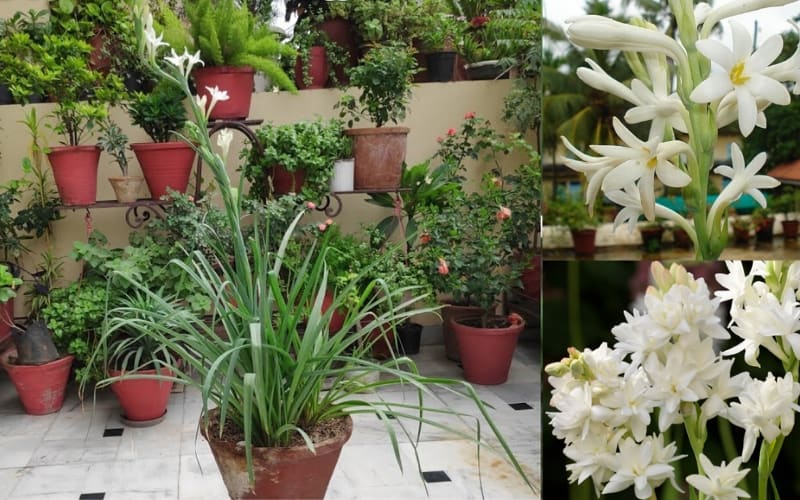What is rajnigandha ?
1. Introduction to Rajnigandha
Rajnigandha, scientifically known as Polianthes tuberosa, is one of India’s most beloved fragrant flowers. Its name translates to “Night-Fragrant Queen” (Rajni = night, gandha = fragrance) in Hindi, a fitting title for this mesmerizing bloom. Native to Mexico but deeply rooted in Indian culture, Rajnigandha is famous for its intoxicating, sweet aroma that intensifies after sunset.
These elegant white flowers grow in clusters on tall green stems and are widely used in weddings, religious ceremonies, and perfumery. In India, they symbolize purity and are often seen adorning hair braids, temple offerings, and festive decorations. The flower’s rich, floral scent has made it a favorite in luxury perfumes and traditional attars.
Did you know? Rajnigandha was the muse behind the iconic 1974 Bollywood film “Rajnigandha”, symbolizing nostalgia and romance. Whether you’ve encountered it in a garden, a garland, or a fragrance, its unforgettable aroma leaves a lasting impression.

2. Key Features of Rajnigandha
Rajnigandha stands out for its unique appearance and enchanting fragrance. The flowers are waxy, white, and star-shaped, blooming on long, slender stalks that can grow up to 3 feet tall. Each stem produces multiple blossoms, creating a stunning visual and olfactory appeal.
One of its most remarkable traits is its nocturnal fragrance—the scent becomes stronger at night, attracting pollinators like moths. This makes it a popular choice for moon gardens and outdoor seating areas. The flower’s essential oil is highly valued in perfumery for its deep, sensual aroma, often compared to jasmine or gardenia.
In different regions, Rajnigandha is known by various names:
- Hindi: Rajnigandha (“Night’s Fragrance”)
- English: Tuberose
- Urdu/Persian: Gul-e-Shabbo (“Night Flower”)
Its long vase life (up to a week when cut) and versatile uses make it a florist’s favorite.
3. Uses of Rajnigandha
Rajnigandha’s versatility extends from spiritual rituals to high-end perfumery. Here’s how it’s used:
A. Religious & Decorative Uses
- Temples & Weddings: Strings of Rajnigandha flowers adorn deities, mandaps, and bridal hairstyles.
- Festivals: Used in garlands during Diwali, Durga Puja, and other celebrations.
B. Perfume Industry
- Its essential oil is a key note in luxury fragrances (e.g., Chanel No. 5, Dior Poison).
- Traditional Attars: Indian perfumers extract its scent for long-lasting ittars.
C. Ayurvedic & Therapeutic Benefits
- Relaxation: Its aroma is believed to reduce stress and anxiety.
- Skin Care: Used in natural cosmetics for its soothing properties.
4. How to Grow Rajnigandha?
Want to grow Rajnigandha at home? Follow these easy tips:
Climate & Soil
- Best Season: Plant bulbs in spring or early summer.
- Soil: Well-drained, slightly acidic soil with compost.
Planting & Care
- Sunlight: Needs 6-8 hours of sunlight.
- Watering: Keep soil moist but avoid waterlogging.
- Blooming: Flowers appear 3-4 months after planting.
Pests & Maintenance
- Watch for aphids; use neem oil as a natural repellent.
- Propagation: Divide bulbs every 2-3 years for more blooms.
5. Interesting Facts About Rajnigandha
- Night Bloomer: Its fragrance peaks after sunset to attract nocturnal pollinators.
- Symbolism: In Victorian times, it represented dangerous pleasure due to its intense scent.
- Bollywood Connection: The movie Rajnigandha (1974) made the flower a cultural icon.
- Perfume Legend: A single pound of tuberose oil requires 1,200 pounds of flowers!
6. Conclusion
Rajnigandha is more than just a flower—it’s a sensory experience tied to tradition, beauty, and fragrance. Whether you grow it in your garden or enjoy its scent in perfumes, this “Queen of the Night” never fails to captivate.